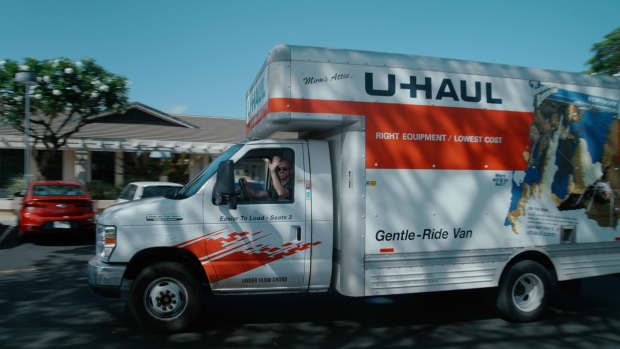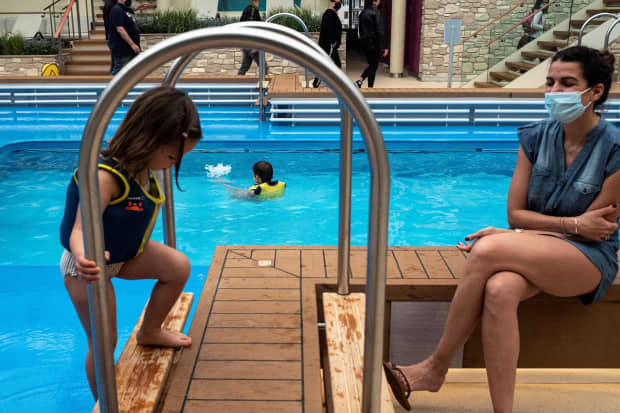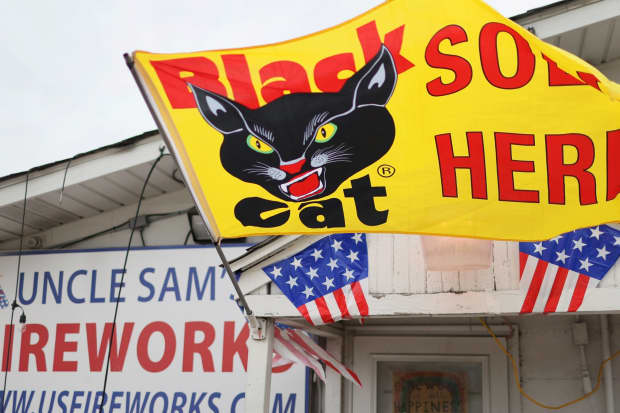It’s an odd choice of vehicle for someone who is not in the moving business.
Up until this week, Matt Landau had never actually driven a U-Haul truck. He is not moving house, and nor is he moving other people’s stuff. Nevertheless, he is driving his moving truck on the streets of Maui, and on the narrow roads through the island’s lava fields. Some people raise their eyebrows, others wave.
In fact, Landau has nothing to do with the moving business. He is the founder of VRMB, a consulting company that helps vacation rental owners and managers grow their business (a business that has taken off in recent months, by the way). He and two members of his staff are on the island for a weeklong trip to visit clients, but he has also mixing in some sightseeing.
A U-Haul was not his first choice for any of this, of course. At the start of the pandemic, millions of consumers noticed a shortage in toilet paper and Clorox CLX, +0.14% wipes. And now more than one year later, people like Landau are finding it hard to purchase other items for a reasonable price.
“ Matt Landau has nothing to do with the moving business, so why did he decide to buy a U-Haul to drive around Maui? ”
When Landau was shopping around for rental cars, he saw daily rates for a normal sedan between $ 400 and $ 500 — “if you could even get one, most were sold out.” He’s now paying an approximately $ 100 daily rate, plus mileage and gas. He gets side eye from local residents. “They clearly identified us as not moving anywhere.”
He does, however, get friendly waves from other U-Haul UHAL, +1.46% drivers. “It’s like a little inside club,” he said. It’s good to tote groceries and paddle boards, said Landau, but it can be tricky to park, and the acceleration is underwhelming. Still, it does the job, and after a long search for a rental car, this is what he ended up with.
Landau’s car-rental dilemma is the predicament many people may find themselves in now: struggling to find certain items at a reasonable price. This is the summer 2021 edition. We’ve already seen this pandemic mismatch on supply and demand. Here are 5 areas where Americans are struggling to find an acceptable price.

Matt Landau in the U-Haul truck he rented for a trip to Hawaii. Photo: Mangofish Studios
Rental Cars
The rental-car shortage stems back to a dearth in chips that are required for a car’s safety systems, braking and entertainment consoles. Tesla TSLA, -0.89% is reportedly willing to pay upfront for the chips and other car makers like Ford F, -2.35%, Volkswagen VOW, -2.80% Daimler DAI, -0.61% have all issued warnings about the shortage.
The shortages and delays create a “domino effect as rental car companies work to increase their inventory of new vehicles in time to meet the increased demand for domestic road travel,” said AAA spokeswoman Julie Hall. People want to see the world, and their friends and family after missing out on summer fun last year.
During Memorial Day Weekend alone, 37 million people will be hitting the road for a trip that’s at least 50 miles away, according to AAA estimates. That’s a 60% increase over the 23 million people who traveled last Memorial Day Weekend, the lowest amount since AAA began its estimates in 2000.
Smaller supplies and higher demands are creating high prices. The average rental rate is currently $ 134 — that’s double the amount from last Memorial Day, Hall said. What’s more, used-car prices surpassed $ 25,000 for the first time, partly due to the global chip shortage, and seating-foam and plastic supply-chain issues.

A couple walks by lifeguard stands sitting on the dry lakebed of Folsom Lake in Granite Bay, Calif. California Gov.
Justin Sullivan/Getty Images
Lifeguards
The City of Toledo, Ohio has six public pools, but on Thursday, it announced it’s currently planning to only open three of those pools due to a lifeguard shortage. “Like many pool operators, locally and across the nation, we have struggled to hire qualified lifeguards,” Mayor Wade Kapszukiewicz said in a statement.
The city needs just eight more lifeguards to open those pools, but other places may need many more. B.J. Fisher, director of health and safety at the American Lifeguard Association, said he anecdotally has been hearing from parks departments, hotels and condominiums that their lifeguard staffs are down 20% to 30%.
There are 309,000 public swimming pools in the U.S. — not counting public beaches, lakes and waterfronts — and these pools need approximately 300,000 lifeguards to be adequately staffed, Fisher said.
“ B.J. Fisher, director of health and safety at the American Lifeguard Association, said lifeguards staffing is down 20% to 30% this year. ”
“We are going to have a substantial number of pools not opening, and a substantial number of pools not at the staffing they’d like to have,” he said.
There are a couple factors at play. Many pools didn’t open last summer to avoid amassing big crowds and when that happened, many would-be lifeguards let their two-year certifications lapse. Certifications also lapsed for instructors who didn’t have lifeguards to certify, Fisher said.
The sun-drenched job had headaches before the pandemic, like too few visas for foreign students who were ready to come overseas and lifeguard, Fisher said.
Beyond that, Fisher noted declining birth rates have lowered the supply of teens and young adults ready to watch the water. Baby boomers have flocked to housing developments with pools, and more customers traveled to water parks.
A whole generation of future lifeguards missed out on a year of swimming skills when pools stayed empty in 2020. So how long will it take for the lifeguard ranks to recover? “It’s going to take a few years,” he said.

Sourcing chlorine has become a problem a year after a boom in swimming-pool construction.
Marco Bertorello/Agence France-Presse/Getty Images
Chlorine
While on the topic of aquatics, there’s snags for a certain form of chlorine.
With no travel plans and shuttered public pools, many Americans last year decided they’d have fun in a backyard pool. Sales soared for all kinds of pools, whether inflatable, above-ground or in-ground.
Builders constructed 96,000 new, residential in-ground pools in 2020, up from 78,000 in 2019, according to Janay Rickwalder, a spokeswoman for the Pool & Hot Tub Alliance, a trade association.
“We’ve never seen this kind growth,” Rickwalder said. Many builders are just as busy now — sometimes even just working through backorders placed last year, she said.
But above- and in-ground need chlorine, and that’s where the problem lies.
“ A Lake Charles, La. factory for a major producer of one commonly-used form of chlorine caught fire during Hurricane Laura in 2020. ”
A Lake Charles, La. factory for a major producer of one commonly-used form of chlorine, known as trichlor, caught fire during Hurricane Laura in August 2020. The company said it’s rebuilding the plant, and working to improve the supply chain.
“We are still producing chlorine tablets and will be supplying them to our retailers throughout the season. Unfortunately, there may be times when retailers do not have adequate supply on the shelves,” BioLab President Jon Viner said this month.
KIK Consumer Products, which owns BioLab, said it aims to resume operations at the site in spring 2022, and will work at 30% greater capacity “which means we will be well-positioned to rapidly address the shortage of pool-disinfecting agents in North America.”
Both Rickwalder and the BioLab statement noted there are other forms of chlorine that pool owners and professionals can use.
“One gallon of chlorinating liquid is equivalent to dosing your pool with two of the traditional 8-ounce chlorinating tablets,” said David Rouse, BioLab’s vice president of Research and Development. Consumers need to be sure the liquid is meant for pool use, he said. “You should be able to find these products at mass, DIY and pool retailers.”

Fireworks are offered for sale in Hammond, Ind. Retailers are encouraging customers to shop early as production and shipping delays from China have already created a shortage of fireworks nationwide.
Scott Olson/Getty Images
Fireworks
This one may make dogs happy, if not humans. Last summer, nights were filled with the constant crack and boom of fireworks. It might be a lot quieter this year.
China makes the vast amount of fireworks and there’s no issue with the supply in China, explained William Weimer, vice president of Phantom Fireworks, a national chain. “The problem we are having is getting fireworks from China to the U.S.”
There’s a shortage of containers and a shortage of space on cargo ships for all the containers, Weimer said. Shipping rules on fireworks containers require them to be stored above deck instead below deck, where any potential chemical leak or explosion would be very bad news.
“ There’s a shortage of containers and a shortage of space on cargo ships for all the containers, and fireworks must be stored above deck due to their flammable nature. ”
Meanwhile, California’s Port of Long Beach is so clogged, Phantom Fireworks has containers that were unloaded from cargo ships in early April and still on the dock, according to Weimer. Last year, much of the fireworks inventory had already arrived by the time shutdown orders started coming, he noted.
Shipping costs have tacked on an extra five figures per container, he said. “We are trying our best to contain the price increase, but we still have to pay bills and pay people, so we can’t possibly eat it all ourselves.”
Many sellers will have to pass along costs, but not dollar for dollar, said Steve Houser, the owner and founder of Red Rhino Fireworks in Joplin, Mo.,
The situation in west coast ports has actually eased somewhat, said Houser, who is also president of the National Fireworks Association, a trade group.
Another problem is finding enough space on railroads or trucks to haul the fireworks east, Inventory at Red Rhino Fireworks, a wholesaler, is down 35% to 40% from the same point last year. It’s common for community groups to buy fireworks and sell them in fundraisers, he noted. Earlier this week, Houser heard from the member of one group who rattled off the regular order.
“I said, ‘We have none of that.’” The customer, disappointed but understanding, said they’d have to cancel the plans, Houser said. “It’s sad because the Fourth of July is supposed to be celebration coast to coast, and a huge part of it is in trouble this year.”

A house under construction is seen in Culver City, Los Angeles. The U.S. real-estate market is booming, meaning more families with modest incomes are seeing their dreams of owning property shattered.
Cchris delmas/Agence France-Presse/Getty Images
Houses
House hunting this Memorial Day Weekend? Long before the weather warmed, housing inventory wasn’t meeting demand. Larger homes, particularly in the suburbs, gained special allure for workers able to do their work remotely. Pending home sales fell 4.4% from March to April, and the housing market as a whole is “ferociously competitive,” according to one analyst.
“Builders are reluctant to sign sales contracts for houses they haven’t broken ground on because of the possibility that costs will continue to rise, nibbling into profits,” said Holden Lewis, housing and mortgage expert at personal-finance website NerdWallet.
“ ‘Some builders are waiting at least until houses are framed before accepting buyers’ offers.’ ”
“Some builders are waiting at least until houses are framed before accepting buyers’ offers,” he added. “This limits the number of home sales, even as demand remains strong.” Other analysts, however, say that builders are desperate to get the market new-housing moving again after the slowdown in activity during the pandemic.
This week, one home price index clocked a 13.2% rise from the same point last year, the largest annual gain since December 2005. The house-buying battle is forcing potential buyers to waive appraisals and sidelining others who say they cannot compete with the cash offers.
A lack of affordable homes for sale is causing the pace of home sales to drop to pre-pandemic levels, the National Association of Realtors warned this week. Every region experienced a monthly decrease in pending home sales, except for the Midwest, where contract signings increased 3.5% on a monthly basis.
